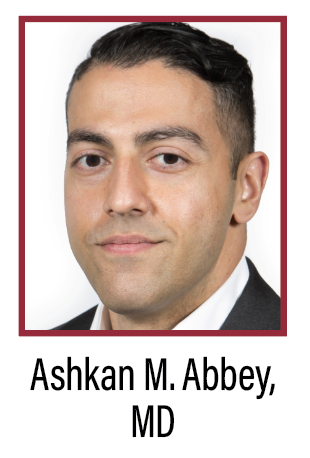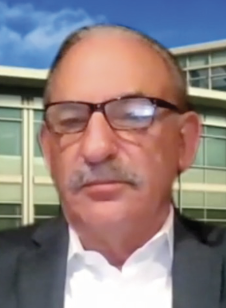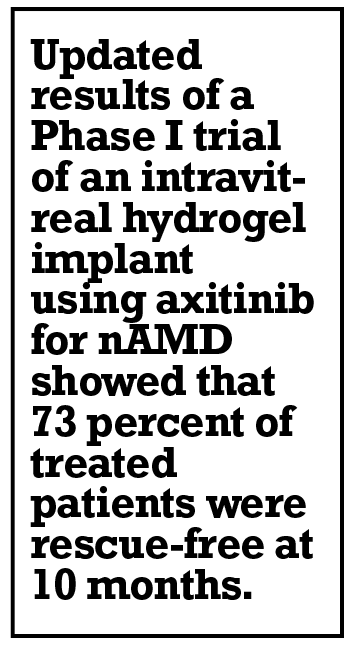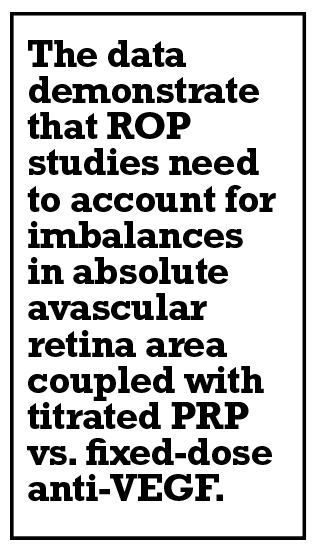 |
|
Bio Dr. Abbey is director of clinical research at Texas Retina Associates, Dallas, and a clinical assistant professor of ophthalmology at the University of Texas Southwestern Medical Center. DISCLOSURES: Dr. Abbey is a consultant to Alcon, Allergan/AbbVie, Alimera Sciences, EyePoint Pharmaceuticals, Genentech/Roche, Novartis and Regeneron Pharmaceuticals. |
Perhaps the most anticipated retina meeting of the first half of the year is Angiogenesis, Exudation, and Degeneration sponsored by Bascom Palmer Eye Institute, University of Miami Miller School of Medicine. Held again virtually last month, the program extended over two days with 11 different sessions on the latest findings for new therapies and strategies for retinal diseases.
Here, we review five abstracts that we think deserve a second look:
- An update on mitochondrial stabilizing agents in nonexudative age-related macular degeneration.
- Updated results of a trial of an axitinib intravitreal implant for neovascular AMD.
- Interim results of efdamrofusp alfa, also known at IBI302, for nAMD.
- Results from a Phase III trial of cell-based therapy for macular telangiectasia type 2.
- A deep dive into anti-VEGF trials in retinopathy of prematurity.
Potential markers for vision restoration in dry AMD
 |
The mitochondrial stabilizing agents risuteganib (Allegro Pharmaceuticals) and elemipretide (Stealth Biotherapeutics) have demonstrated a signal for restoring functional vision in intermediate non-neovascular AMD patients with high levels of anatomical integrity, according to an analysis of trials for both agents.1
Mitochondrial defects are a hallmark of AMD. Baruch D. Kuppermann, MD, PhD, noted that elamipretide stabilizes cristae architecture and electron transport chain structure during oxidative stress by binding to cardiolipin in the inner mitochondrial membrane. Risuteganib preserves mitochondrial structures in retinal pigment epithelium cells under stress. Dr. Kuppermann is the Steinert Endowed Professor and chair of ophthalmology and director of the Gavin Herbert Eye Institute at the University of California Irvine.
He focused on the Phase IIa trial of risuteganib 1 mg (n=40), with 25 receiving treatment and 15 in the sham arm. The treatment group received risuteganib at baseline and 16 weeks, with an endpoint analysis at 28 weeks. The final endpoint evaluation for the sham group was 12 weeks, but at 16 weeks they crossed over to get a risuteganib injection.
Best-corrected visual acuity improvement in the treatment vs. sham arms were: ≥8-letter improvement, 48 vs. 7.1 percent (p=0.013); ≥10-letter improvement, 32 and 7.1 percent (p=0.118); and ≥20-letter improvement, 20 and 0 percent (p=0.139).
The analysis also captured predictors of response to risuteganib. While age, race/ethnicity and genotype didn’t correlate with response, baseline optical coherence tomography findings did. Predictors include enhanced ellipsoid zone integrity, greater outer retinal thickness and decreased levels of geographic atrophy. Future clinical trials need to establish thresholds such as EZ and RPE thickness to cull study populations, Dr. Kuppermann said.
DISCLOSURE: Dr. Kuppermann is a consultant and researcher for Allegro Ophthalmics.
Bispecific antibody shows improvement in nAMD
 |
Thirty-six-week results of a Phase II trial of the bispecific protein efdamrofusp alfa (IBI302, Innovent Biologics) demonstrated that 2- and 4-mg doses were well-tolerated in nAMD patients and led to improvements in BCVA and central subfield thickness.2
Xiaodong Sun, MD, professor of the National Clinical Research Center for Eye Disease and Shanghai General Hospital, described IBI302 as a novel bispecific decoy receptor fusion protein that targets vascular endothelial growth factor and the complement C3b/C4b pathways. He reported on a trial in China that enrolled 231 patients randomized 1:1:1 to IBI302 2 or 4 mg and aflibercept 2 mg. Eligibility criteria included choroidal neovascularization secondary to nAMD with BCVA 24 to 73 letters and age 50 years or older.
Changes in BCVA were 11.22 ± 10.8, 12.06 ± 11.75 and 12.46 ± 9.62 letters for the 2- and 4-mg IBI302 and aflibercept arms, respectively. The comparable proportion of patients who gained ≥10 letters were 45.45, 46.75 and 51.95 percent.
Reductions in CST were –132, –156 and –148 µm in the respective arms. Fibrosis rates were comparable across the three arms, but the rate of macular atrophy was lowest in the IBI302 4-mg arm, 2.6 percent vs. 5.19 and 7.79 percent in the IBI302 2-mg and aflibercept arms, respectively.
Safety profiles across all three arms were also comparable, Dr. Sun said. No cases of occlusive retinal vasculitis were reported. Full 52-week data are pending and a Phase III trial is upcoming.
DISCLOSURES: Dr. Sun is a consultant to Novartis, Roche, Bayer and Innovent.
Axitinib implant outcomes extend to 10 months
 |
Updated results of a Phase I trial of an intravitreal hydrogel implant using the tyrosine kinase inhibitor (TKI) axitinib for treatment of nAMD showed that previously reported outcomes of 73 percent of treated patients remaining rescue free at seven months were maintained out to 10 months.3
Andrew A. Moshfeghi, MD, MBA, associate professor at the Keck School of Medicine, University of Southern California Roski Eye Institute, reported the interim 10-month data of the trial that randomized patients 3:1 to the axitinib implant OTX-TKI (Ocular Therapeutix) or aflibercept (n=20). Implant recipients had a 92 percent reduction in anti-VEGF injections at 10 months.
Axitinib is a highly selective inhibitor of all vascular endothelial and platelet-derived growth factors. The implant is delivered via a 25-gauge needle and gets resorbed in six to 12 months.
 |
Inclusion criteria included response to anti-VEGF therapy and control of macular exudation at enrollment. Patients had their last anti-VEGF treatment one month before screening. OTX-TKI patients were dosed at baseline. Aflibercept patients received a sham dose at baseline. At one month, patients in both arms received the mandatory aflibercept injection. After that, aflibercept patients were treated every eight weeks. Rescue treatments were at the treating investigator’s discretion.
Vision and CST changes were comparable between both groups. BCVA change from baseline to month 10 was –0.3 (standard deviation 5.1) letters and –0.8 (2.8) letters in the OTX-TKI and aflibercept arms. Mean change in CST was –1.3 (23.7) and –4.5 (4.4) µm in the respective arms.
No ocular or systemic serious adverse events were reported in either arm. The study is ongoing and the next data report is due after the 12-month endpoint. A separate Phase I trial is under way in diabetic retinopathy.
DISCLOSURES: Dr. Andrew Moshfeghi is a consultant to and shareholder in Ocular Therapeutix and Regeneron Pharmaceuticals.
 |
Cell-based therapy to treat MacTel2
The progression rate of EZ area loss for control/sham patients was similar to that observed in the natural history study, ranging from 0.5 to 0.7 mm2 at 24 months. In study B, the treatment group had a 27.8-percent reduction in the rate of EZ area loss compared to sham (p=0.0294). In the intent-to-treat analysis, the treatment group had a 29.2 percent reduction in EZ area loss rate vs. sham (p=0.021).
In study A, the effect at 24 months was even more pronounced for the treatment arm: a 55.9 percent reduction in progression in the per-protocol analysis (p<0.0001) and a 56.4 percent reduction in the intent-to-treat analysis (p<0.0001).
Next steps are to identify treatment responders or to show if earlier intervention has more impact on outcomes. An analysis of secondary endpoints and a meta-analysis are also planned, Dr. Friedlander said.
DISCLOSURE: Dr. Friedlander has no relationships to disclose.
 |
The analysis included the following trials: BEAT-ROP, with bevacizumab 0.5 mg; RAINBOW with ranibizumab 0.2 and 0.4 mg; and FIREFLEYE and BUTTERFLEYE, both with aflibercept 0.4 mg. Darius Moshfeghi, MD, professor of ophthalmology and chief of the retina division at Byers Eye Institute, Stanford University School of Medicine, Palo Alto, California, noted that the anti-VEGF medications “underperformed” expectations across the board. Only one arm in the BEAT-ROP trial—eyes with zone 1 ROP—met expectations.
 |
BEAT-ROP is notable because it used 50 percent of the adult dose of bevacizumab, whereas the other trials used 20 to 40 percent of the adult dose. Meanwhile across all the trials, the efficacy of PRP improved over time. If done properly, the extent of laser treatment is titrated based on the amount of avascular retina, whereas anti-VEGF therapy is based on fixed dosing. “It’s an unfair fight a priori when you start off because we’re tailoring the laser but we’re not tailoring the anti-VEGF therapy,” Dr. Darius Moshfeghi said.
The data demonstrate that ROP studies need to account for imbalances in absolute avascular retina area coupled with titrated PRP vs. fixed-dose anti-VEGF. The findings may be applicable to other pediatric retinopathies, most notably familial exudative vitreoretinopathy (FEVR). However, studies of FEVR also need to account for the role of lipids as well as neovascularization and ischemia, he said.
DISCLOSURES: Dr. Darius Moshfeghi has no relevant relationships to disclose. RS
REFERENCES
1. Kuppermann BD. Reversing vision loss in dry AMD: Matching mechanism with the right patient population and stage of disease: Risuteganib for dry AMD. Paper presented at Angiogenesis, Exudation and Degeneration Meeting Virtual; February 10, 2023.
2. Sun X, Lu S, Jia H, Li T, Qian L. Primary endpoint results of a Phase II study of IBI302 (efdamrofusp alfa): A bispecific protein targeting VEGF & complement in patients with nAMD: Multi-center, randomized, active controlled trial. Paper presented at Angiogenesis, Exudation and Degeneration Meeting Virtual; February 11, 2023.
3. Moshfeghi AA, Couvillion SS, Eichenbaum DA, et al. Update on a hydrogel-based axitinib implant (OTX—TKI) for the treatment of neovascular age-related macular degeneration. Paper presented at Angiogenesis, Exudation and Degeneration Meeting Virtual; February 11, 2023.
4. Friedlander M. Results of the Phase 3 MacTel 2 CNTF trial: It worked!! Paper presented at Angiogenesis, Exudation and Degeneration Meeting Virtual; February 11, 2023.
5. Moshfeghi D, Wang SK, Moshfeghi HP, et al. Avascular retina as the risk factor for failure in BEAT ROP and anti-VEGF clinical trials. Paper presented at Angiogenesis, Exudation and Degeneration Meeting Virtual; February 11, 2023.



